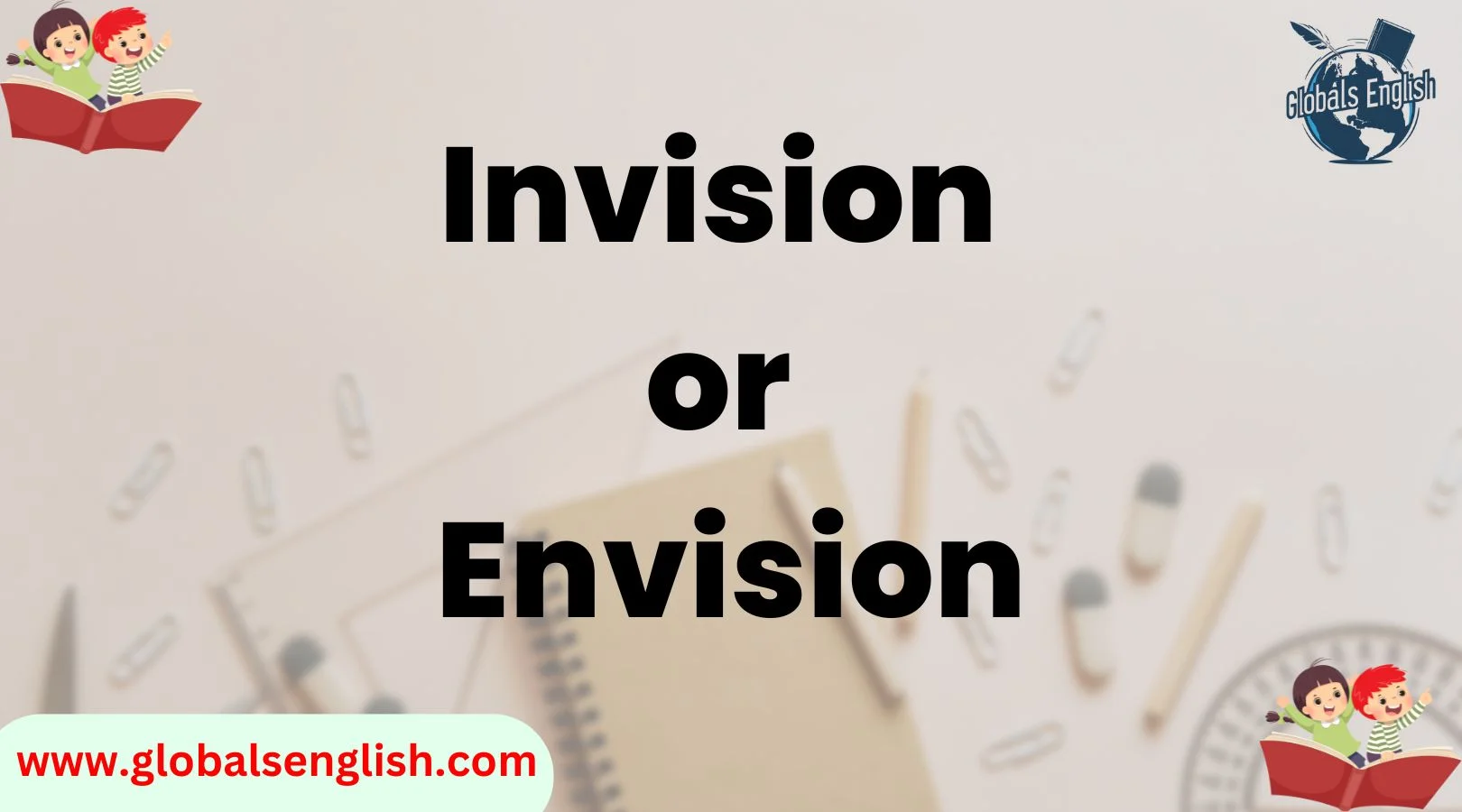Knowing the different aspects of English language could come very handy, especially when it comes to spelling. With words that sound alike, but have different meanings and have different ways of spelling them, makes English critical. A common area of confusion stems from using the word “invision” as compared to “envision”.
While these two words may seem very closely related, only one is correct. If you try to use the incorrect one, you risk ambiguity. So, what’s the difference? In these next passages, we will analyze the linguistics, anthropology, and history of the words offer deep insight into these issues.
They are sure to discern how to use these words in casual and professional settings, drawing from expertise and experience. You will have sound knowledge of these issues at the end and know why it matters which one you should use and which term is accurate.
What Does ‘Envision’ Mean?
The term “envision” means to imagine or foresee something in the future. It’s often used when describing a vision, plan, or idea that someone wants to bring into reality. The word comes from the prefix “en-“, which means “to cause to be,” and the root word “vision,” referring to sight or the ability to see.
In a sentence, it could be used like this: “She envisioned a world where renewable energy powers every home.”
Envision in Literature and Media
“Envision” is commonly used in literature, movies, and media to describe the act of imagining something vivid or extraordinary. Authors and filmmakers often use it to express what characters imagine for their future or a dream-like scenario.
For example, in science fiction, envisioning futuristic worlds is a central element. Writers like Isaac Asimov or Philip K. Dick often used “envision” to describe the complex, imagined futures in their novels.
Envision in Everyday Language
In everyday conversation, “envision” is typically used to describe one’s personal thoughts or plans. For example: “I envision myself living in a small coastal town by the ocean.”
In business, “envision” is often used in strategic planning or vision statements. Many CEOs or entrepreneurs use it to describe the future goals of their companies. For instance, a company might say: “Our leadership team envisions a world where our product empowers small businesses globally.”
What Is ‘Invision’ and Is It a Mistake?
Now, let’s talk about the word “invision.” While it may sound like a reasonable alternative, “invision” is actually a misspelling or incorrect form of “envision.” It doesn’t appear in most standard dictionaries, and you won’t find it used correctly in professional or academic writing.
Is ‘Invision’ Ever Correct?
There are a few rare exceptions where “invision” might appear intentionally. For example, InVision is a popular design and prototyping tool used by UX/UI professionals. But in this case, it’s a brand name, not the verb you use to describe envisioning something. So while InVision is perfectly fine as a brand name, it still doesn’t work as the correct verb.
For general use, “invision” should always be avoided unless referring to specific names or trademarks.
Why ‘Invision’ is Typically Incorrect
Many people mistakenly use “invision” due to its similarity in sound to “envision.” This error often arises from people hearing the word and not being familiar with the correct spelling. While the “in-“ prefix often implies something negative or opposite, such as in “incorrect” or “incomplete,” it doesn’t apply in this case. “Envision” correctly uses the prefix “en-” to indicate visioning or seeing.
The confusion also arises because English spelling rules are inconsistent. There are many instances in which words with similar sounds can be spelled differently. However, in this case, using “invision” instead of “envision” is simply incorrect, both grammatically and linguistically.
Linguistic Breakdown: The Importance of ‘Envision’
Understanding the linguistic basis of “envision” can help clarify why it’s the correct form. The prefix “en-“ comes from Latin and means “to cause to be” or “to make.” When combined with the word “vision,” it creates the idea of causing something to be imagined or seen, often in the mind’s eye.
The Role of Prefixes in English
Prefixes are essential to understanding English word formation. In the case of “envision,” the prefix “en-“ plays a crucial role in transforming the word into a verb. Other examples of this prefix include “enlighten” and “empower,” both of which mean to bring something into being.
If we were to use “in-“ instead, it could suggest the opposite or negate the action. This is why “invision” doesn’t work as a correct term for imagining or visualizing.
Historical and Cultural Context of ‘Envision’
The term “envision” has a long history in the English language. It was first used around the 17th century and has since become the go-to word for describing the act of seeing something mentally. Its use in literature and everyday conversation grew rapidly as more and more people began to understand the power of imagining future possibilities.
The Influence of British and American English
Interestingly, the confusion between “invision” and “envision” could have been influenced by variations between British and American English. While “envision” is commonly used in both dialects, there may be cases where regional differences contributed to the misspelling or alternate usage.
For example, in some business contexts, especially in the UK, professionals sometimes mix up these terms. However, in formal writing and professional communication, “envision” remains the preferred and correct form.
Envision vs. Invision in Modern Usage
In modern usage, “envision” continues to dominate across all forms of writing and speech. Whether in corporate settings, creative industries, or day-to-day conversations, “envision” is the standard term. On the other hand, “invision” remains mostly confined to instances of brand names or unintentional typos.
Examples of Correct Usage in Different Contexts
Let’s take a closer look at how “envision” is used in specific contexts:
- Professional Contexts: “The CEO envisions a future where AI plays a central role in healthcare.”
- Creative Fields: “The artist envisions a world where technology and nature coexist harmoniously.”
- Personal Planning: “I envision myself achieving financial freedom by the age of 40.”
These examples showcase the flexibility and versatility of the word “envision” in different contexts.
Social Media and the Rise of ‘Invision’
Despite “invision” being incorrect in most cases, social media platforms like Twitter and Instagram often showcase this mistake. It’s not uncommon to see users misspell words, and “invision” has gained some traction in online discussions, particularly in reference to design tools or brand names. While this may seem like a minor issue, it underscores the importance of understanding spelling and terminology when trying to communicate effectively.
Frequently Asked Questions (FAQs)
1. Is “Invision” a correct word?
No, “invision” is generally considered a misspelling of “envision.” While it may be used as a brand name (e.g., InVision design tool), it is not a standard word in the dictionary and should not be used in place of “envision.”
2. When can “Invision” be used?
The only time “invision” is acceptable is when referring to specific brand names, like InVision, a popular design tool used by UI/UX designers. Outside of this context, “invision” should be avoided.
3. What does “envision” mean?
“Envision” means to imagine or mentally visualize something, especially something that might happen in the future. For example, “I envision a world where renewable energy is the norm.”
4. Can “envision” and “invision” be used interchangeably?
No, “envision” and “invision” cannot be used interchangeably. “Envision” is the correct word, while “invision” is a common misspelling. Using “invision” in place of “envision” may undermine the credibility of your writing.
5. How do I use “envision” in a sentence?
“Envision” is used to describe a future plan, idea, or mental image. For example:
- “The company envisions expanding internationally in the next five years.”
Conclusion
In conclusion, “envision” is most suited to represent the act of imagining, visualizing, or planning for something that is set to take place in the future. “Invision” is at best a brand name and does not hold general value, at worst it is a misspelling. Sticking to “envision” allows one to communicate precisely and clearly, which is vital in all aspects of a person’s life.
Always remember that spelling and choice of words is something that one should not take lightly, especially with how intricate written communication can get. Always strive to look and appear professional by using the appropriate words and displaying a grasp of logical reasoning.
Now, whether it be in business communications or casual conversation with non-business associates, opt for “envision” instead of “invision.” The likelihood of your message getting mangled is slim and credibility is bound to increase.

Mia Rose are the minds behind Globals English, a platform dedicated to making English learning simple, engaging, and effective. With a shared passion for education and communication, they bring years of experience in language teaching and curriculum development.
